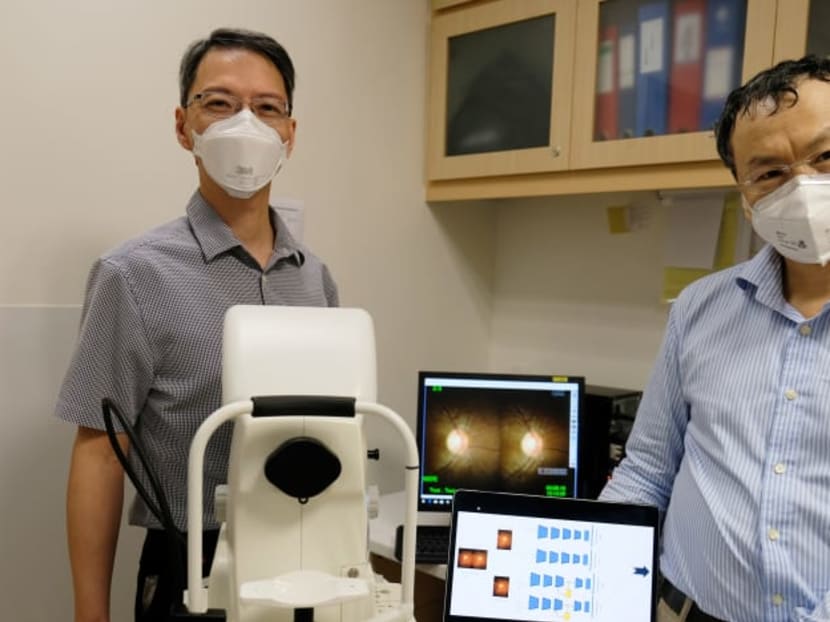NTU, TTSH scientists develop glaucoma diagnosis system powered by artificial intelligence
SINGAPORE — Scientists from Singapore’s Nanyang Technological University (NTU) and clinicians from Tan Tock Seng Hospital (TTSH) have developed a new method of screening for glaucoma using artificial intelligence (AI).

Dr Leonard Yip (left) from Tan Tock Seng Hospital and Assoc Prof Wang Lipo from Nanyang Technological University led a team to develop a novel method that uses AI to screen for glaucoma.
SINGAPORE — Scientists from Singapore’s Nanyang Technological University (NTU) and clinicians from Tan Tock Seng Hospital (TTSH) have developed a new method of screening for glaucoma using artificial intelligence (AI).
Glaucoma is a group of eye diseases that can cause vision loss and blindness through damage to the optic nerve at the back of the eye.
It can be treated but not cured. The disease is the principal cause of irreversible blindness worldwide, NTU and TTSH said in a joint news release on Tuesday (Sept 7), adding that it affected 76 million people in 2020.
The AI-enabled method developed by NTU and TTSH uses algorithms to differentiate optic nerves with glaucoma from those that are normal. This is done by analysing "stereo fundus images", which are multi-angle two-dimension (2D) images of the retina that are combined to form a three-dimension (3D) image.
When tested on stereo fundus images from TTSH patients undergoing expert examination, the AI method yielded an accuracy of 97 per cent in diagnosing glaucoma, the institutions said.
"Glaucoma is often called ‘the silent thief of sight’ as it is usually asymptomatic until latter stages, when prognosis is poor," said NTU and TTSH.
HOW IT WORKS
NTU and TTSH’s new screening method uses a set of algorithms to analyse stereo fundus images taken as pairs by two cameras from different viewpoints. These 2D "left and right" images of the fundus help to form a 3D view when combined.
Using two images ensures that if one image is poor quality, the other image can "usually compensate" and the system can maintain its accurate performance, said the scientists.
The automated glaucoma diagnosis method could potentially be used in less developed areas where patients lack access to ophthalmologists, said the scientists.
The ability to diagnose glaucoma from fundus images removes "the need for ophthalmologists to take various clinical measurements (such as internal eye pressure) for diagnosis", Associate Professor Wang Lipo of NTU’s School of Electrical and Electronic Engineering said.
“The ease of use of our robust automated glaucoma diagnosis approach means that any healthcare practitioner could make use of the system to help in glaucoma screening."
Dr Leonard Yip, who heads the glaucoma service at the National Healthcare Group Eye Institute at TTSH, said many glaucoma patients remain undiagnosed in the community.
"Many glaucoma patients remain undiagnosed in the community, and in developing countries like India, the percentage of undiagnosed cases may be well over 90 per cent," said Dr Yip, who is a co-author of the study.
"While cases are usually picked up during routine eye checks, population-based screening is challenging due to the specialised and expensive equipment or trained experts required.
"The process of manually inspecting individual retinal images is also time-consuming and depends on subjective evaluation by experts. Our method of using AI, in contrast, could potentially be more efficient and economical.”
The team is now testing their algorithms on a larger dataset of patient fundus images taken at TTSH.
They are also “looking at how the software can be ported to a mobile phone application so that, when used in conjunction with a fundus camera or lens adaptor for mobile phones, it could be a feasible glaucoma screening tool in the field,” NTU and TTSH said.
“A portable AI-powered tool, which we envision our screening model to eventually take the form of, could also help to tackle the problem of poor access to primary healthcare and errors in differential diagnoses,” Dr Yip added.
Besides a 97 per cent accuracy rate, the screen method had a sensitivity — the fraction of cases correctly classified among all positive glaucoma cases — of 95 per cent.
This is "higher than other state-of-the-art deep learning based-methods also trialled during the study, which yielded sensitivities ranging from 69 to 89 per cent", said NTU and TTSH.
Assoc Prof Wang said: “Excellent and stable performance is especially important in medical diagnosis, and this study has shown that our model of combining deep convolutional neural network with attention mechanisms has resulted in a reliable and efficient AI-enabled screening approach for glaucoma.”
He added the team would now look to "further finetune" the algorithms.
Their study was published in the peer-reviewed scientific journal Methods in June. CNA
For more stories like this, visit cna.asia






